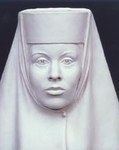Mother Stepanida Ivanovna Siblings Boris Godunov House Rurik dynasty | Name Irina Godunova Religion Eastern Orthodox | |
 | ||
Tenure 18 March 1584 – 16/17 January (NS), 1598 Issue Tsarevna Feodosia Feodorovna Father Feodor Ivanovich Godunov Children Tsarevna Feodosia Feodorovna of Russia Similar People Boris Godunov, Feodor I of Russia, Feodor II of Russia, Anastasia Romanovna, Tsarevna Xenia Borisovn | ||
The life and death of irina godunova
Irina Feodorovna Godunova later Alexandra (1557–1603) was a Tsaritsa of Russia by marriage to Tsar Feodor I Ivanovich (r. 1584–1598) and the sister of Tsar Boris Godunov (r. 1598–1605).
Contents
Life
The precise dates of some of the events in Irina's life are uncertain; most sources indicate that she was picked by Ivan the Terrible to be the wife of the tsarevich Fedor in 1580 or 1581, although some sources say this occurred as early as 1574. At 23 or 24 (assuming the latter dates), she would have been considered old for a bride in Muscovy, where the common age for marriage was in the mid-teens, and it is not certain why she married so relatively late in life. She became Tsaritsa upon the coronation of her husband in 1584.
Tsaritsa
Throughout her husband's reign (and, indeed, ever since her marriage), she was expected to produce a male heir. Fedor was physically and mentally frail and, were he to die without male issue, it was questionable whether his half-brother, Dmitri, would be considered legitimate, as he was the result of Ivan the Terrible's seventh marriage and the Orthodox Church recognized only up to four marriages as legitimate. Indeed, even with Dmitri as a possible successor, Irina was under pressure to produce an heir and in 1585, she traveled to the Trinity-St. Sergei Monastery north of Moscow in hopes of a miraculous cure for her alleged infertility, but still she did not bear a child—a daughter, Feodosia Fedorovna—until 1592, but the girl did not live long and died in January 1594.
The couple's continued infertility led to court intrigue. Thus, in 1585, Metropolitan Dionysius proposed that Feodor divorce Irina, blaming her for being infertile and arguing that, for the good of the state and the dynasty, the Tsar ought to remarry and produce a male heir. The suggestion was seen as an effort on the part of the Shuiskies and other boyar clans to undercut the Godunovs. In response, Boris Godunov had the metropolitan deposed and confined to the Khutyn Monastery just outside Novgorod the Great.
With the death of Dmitry under strange circumstances in Uglich, north of Moscow, on 15 May 1591, Irina was placed under increasing pressure to produce an heir as the Rurikid dynasty that had ruled Rus and Muscovy since the ninth century would be extinct if Fedor died without a son, and a bloody succession struggle might ensue. The couple remained barren for more than a decade, although whether this was due to Fedor's poor health or to infertility on Irina's part was uncertain.
Later life
Upon her husband's death on 7 January 1598, it is possible that Irina herself could have taken the throne as the reigning tsaritsa (rather than a mere consort), since the Rurikids in the male line were extinct; that being said, no woman had ever before reigned in her own right in Rus' or Russia. Thus she retired (some historians call it an abdication) to the Novodevichy Monastery (Convent) on the south side of Moscow, where she took monastic vows under the name Aleksandra. In fact, it was at the monastery that Boris Godunov was asked by Patriarch Job of Moscow and the Zemsky Sobor to become tsar.
Irina died on 27 October 1603 (others sources give the date 26 September, still others the year 1604) in the Novodevichy Monastery.
Legacy
Several embroideries created by Irina are in the collection of the State Russian Museum on Red Square (along with similar work by Sophia Paleologus, the wife of Ivan III, and Anastasia, the first wife of Ivan the Terrible.)
